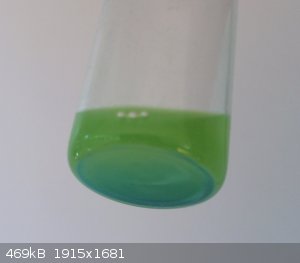Keras
National Hazard
   
Posts: 768
Registered: 20-8-2018
Location: (48, 2)
Member Is Offline
|
|
Unknown blue/grey copper II salt?
Hey there,
when I get bored, I do senseless things.
So yesterday, I took a 1 eurocent coin (basically copper over iron), plunged it into hydrochloric acid. Of course, nothing happened. Then I added some
beads of sodium percarbonate. The solution bubbled, and I was left with a corroded coin and a somewhat bluish solution. I took the coin out, then
dipped a ball of aluminium foil, and of course it immediately bubbled again (and fumed), the aluminium dissolved and I was left with a dark red powder
in suspension, that I later washed out with tap water. Couldn't decide if that was copper metal or copper (I) oxide.
This morning, on the dry powder I poured a bit of chlorhydric acid. Nothing (I expected copper (I) oxide to dissolve in HCl and go to Cu (II)). I then
added some oxalic acid (don't ask me why). Still nothing. So I dropped again sodium percarbonate and there something strange happened: the red powder
dissolved and was replaced by a greyish blue precipitate. That seems to be some Cu (II) salt, but I can't decide if it's chloride, oxalate, or a mix
of both. Nor have I found the description of a copper II salt as being of this particular colour. Any idea?
|
|
|
woelen
Super Administrator
        
Posts: 7976
Registered: 20-8-2005
Location: Netherlands
Member Is Offline
Mood: interested
|
|
The dark red powder is copper metal. At the strongly acidic conditions of your experiment you certainly don't get any oxide. This also explains why
nothing happened when you added hydrochloric acid to the red powder. The metal does not react with hydrochloric acid (at least not quickly, it does
react slowly in the presence of O2 besides the hydrochloric acid).
In the final step the metal is oxidized by the peroxide in the percarbonate and the acid. Probably you added some excess percarbonate and that gives a
blue precipitate with copper(II), of which a part is converted to copper peroxide (which is dark brown) if you have excess percarbonate added, so that
the liquid is alkaline.
|
|
|
Keras
National Hazard
   
Posts: 768
Registered: 20-8-2018
Location: (48, 2)
Member Is Offline
|
|
Quote: Originally posted by woelen  | The dark red powder is copper metal. At the strongly acidic conditions of your experiment you certainly don't get any oxide. This also explains why
nothing happened when you added hydrochloric acid to the red powder. The metal does not react with hydrochloric acid (at least not quickly, it does
react slowly in the presence of O2 besides the hydrochloric acid).
In the final step the metal is oxidized by the peroxide in the percarbonate and the acid. Probably you added some excess percarbonate and that gives a
blue precipitate with copper(II), of which a part is converted to copper peroxide (which is dark brown) if you have excess percarbonate added, so that
the liquid is alkaline.
|
Thanks a bunch for that! So the precipitate would be copper II carbonate hydroxide?
[Edited on 22-5-2019 by Keras]
|
|
|
woelen
Super Administrator
        
Posts: 7976
Registered: 20-8-2005
Location: Netherlands
Member Is Offline
Mood: interested
|
|
I think so, but probably with some peroxide contamination and some chloride contamination.
|
|
|
Keras
National Hazard
   
Posts: 768
Registered: 20-8-2018
Location: (48, 2)
Member Is Offline
|
|
Well, this morning I dropped a bit of HCl in the tube, but nothing happened. I'm still having this grey/blue deposit sitting at the bottom of it,
soaked in a green liquid (my HCl is stained yellow, low quality product basically sold to descale toilets, so I suppose there must be a small quantity
of Cu II floating around). Have a picture.

|
|
|